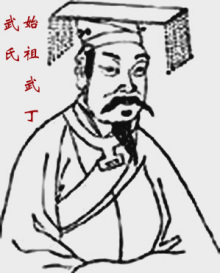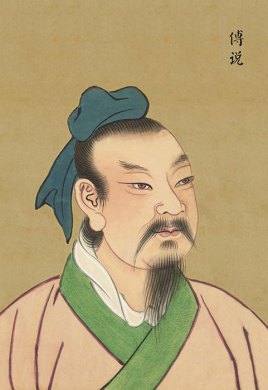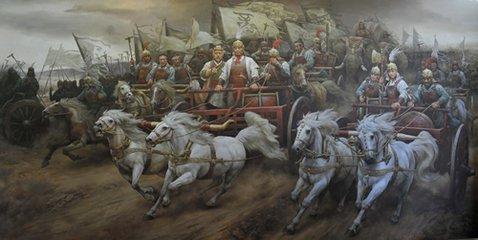
- The rule of Xiao Yi
Xiao Yi, the 22nd ruler of the Shang Dynasty, was actually the younger brother of his predecessor Xiao Xin, and there was always confusion over the kingship of the Shang Dynasty. According to the Records of the Grand Historian, “Since the death of Zhongding, he abolished his disciples and established them in his place. After Yangjia came Pan Geng, whose greatest contribution was the famous “move of the capital to Pan Geng”, but after that the Shang dynasty declined again. According to the book “The Chronicles of the Bamboo Book”, Xiao Yi reigned for ten years, his surname was Zi Zi, son of Nan Geng, and his temple name was Xiao Yi. In fact, the three main achievements of Xiao Yi’s reign were: allowing his son Wuding to farm, which laid a solid foundation for Wuding’s rise to power; conquering the Eastern barbarians and ghosts, which further weakened the power of the Fang state; and developing the Shang sacrificial system, so it is no wonder that Xiao Yi was posthumously sacrificed to King Hui of Shang after his death.
- Fu said reform
Testimony of Fu Shuo’s appointment as minister
After Wu Ding was banished, he befriended “said”, who was born as a criminal and worked as a wall-painter in Fu Yan, and because of this, future generations regarded “said” as the first saint in Chinese history, and the first famous architect. He was also the first famous architect. Wu Ding met him and asked him for advice on how to rule the country, and he decided that “Say was his first reform mastermind”. Therefore, when Wuding succeeded to the throne, he remembered the wall builder Say. Wuding knew that if he rashly appointed Say as prime minister, it would inevitably cause discontent and hatred among the Shang nobles, because Say was only a wall builder, and the “Ancient Text of Shang Shu – Saying Life” said: “Say built Fu Yan Zhi Ye”. So Wu Ding pretended that Shang Tang had a dream and summoned the nobles, saying that the previous king had a dream that a wise man would assist Yin Shang, who was still a god, and that Shang Tang, the founding monarch of Yin Shang, had destroyed the Xia Dynasty with the political slogan “Xia Jie does not respect ghosts and gods and does not respect the Mandate of Heaven”. These nobles naturally agreed with the wisdom of the previous king, so he was appointed prime minister and was ranked as one of the three masters, so he took Fu as his surname, and the first reformer in the history of Yin Shang was born! In the “Shang Shu – said life” of “Kong Chuan”, it is recorded that Fu Yan between Yu and Guo was originally a major traffic road, because the river often flooded and washed away the road, so it was necessary to mobilize prisoners to build, Fu said is a local hermit, volunteered to build the road with the prisoners, the purpose is to meet the food.

- The Economic Basis for Wu Ding’s Revival
During the Wuding period, the productivity level of the Yin Shang was high, especially the large-scale use of bronze tools, which were already more perfect during the Wuding period. “, which is well made and reflects a certain level of bronze. The Houmuwu Tripod, for example, is the largest and heaviest bronze ritual vessel ever unearthed in the world, and enjoys the reputation of being the “treasure of the state”.
The agricultural level of the whole society in the Wuding period was also high. The tools used at that time were stone tools, mussel tools, and bone tools. More than 400 stone scythes were found in the palace area of Yinxu. Bronze farming tools were also found. Of course, this is not a large number. But the tools have improved. Hundreds of grain cellars have been found at the ruins of Yin, indicating that wine was produced in large quantities during this period, as documented in the Shang Shu (The Book of Wine).
It was the development of agriculture and handicrafts, among other things, that laid a solid foundation for the renaissance of Wuding.

- Historical evaluation of the renaissance of Wuding
During that period, the Chinese nation’s overall interests were safeguarded to the greatest extent possible, and it was also Wu Ding’s Revival that continued and preserved the Chinese civilization. After a coup d’état, Wu Ding succeeded to the throne and completed another Shang revival after the “Nine Worlds’ Rebellion” (the other one was Pan Geng’s move to the capital), which focused mainly on the military and secondarily on politics. After his death, he was succeeded by his son Zu Geng, and no subsequent Shang king had ever conducted such a large-scale military campaign.
However, Wu Ding’s reign was built on the blood and tears of the slaves, and the massive military operations all year round undoubtedly brought deep disaster to the people at the bottom, especially those who were conquered by the Fang states, whose estates were destroyed and people were reduced to slaves, which was the objective situation that existed during that period. Therefore, Wu Ding Zhongxing is still built on top of the slave society of the ruling class in search of revival in the form of war a reform!